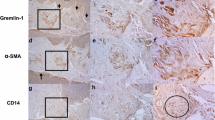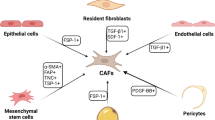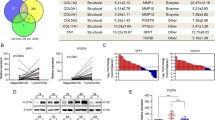Abstract
Background
The tumor microenvironment (TME) is known to play a prominent role in the pathology of head and neck squamous cell carcinoma (HNSCC). Cancer-associated fibroblasts (CAFs) have been reported to regulate tumor progression, and serglycin (SRGN), one of the paracrine cytokines of CAFs, has been reported to play an important role in various signaling pathways. Hypoxia is a distinct feature of the HNSCC TME. Here, we investigated the mechanism underlying CAF-secreted SRGN leading to HNSCC progression under hypoxia.
Methods
Immunohistochemical staining was used to detect SRGN expression in clinical HNSCC samples, after which its relation with patient survival was assessed. CAFs were isolated and SRGN expression and secretion by CAFs under normoxia and hypoxia were confirmed using qRT-PCR and ELISA assays, respectively. HNSCC sphere-forming abilities, stemness-related gene expression, and chemoresistance were assessed with or without SRGN treatment. A Wnt/β-catenin pathway inhibitor (PNU-75,654) was used to block its activation, after which nuclear translocation of β-catenin in the presence of SRGN with or without PNU-75,654 was evaluated. shRNAs were used to stably knock down SRGN expression in CAFs. HNSCC tumor cells with or without (SRGN silenced) CAFs were inoculated submucosally in nude mice after which tumor weights and sizes were determined to assess the effects of CAFs and SRGN on tumor growth.
Results
We found that SRGN was expressed in both HNSCC tumor and stroma cells, and that high SRGN expression in the stroma cells, but not in the tumor cells, was significantly related to a poor patient survival. After the extraction of CAFs and normal fibroblasts (NFs) from paired tumor samples and adjacent normal tissues, respectively, we found that the expression of CAF-specific genes, including fibroblast activation protein (FAP) and alpha-smooth muscle actin (α-SMA), was clearly upregulated compared to the expression in NFs. The hypoxia marker HIF-1α was found to be expressed in tumor stroma cells. Hypoxyprobe immunofluorescence staining confirmed stromal hypoxia in an orthotopic tongue cancer mouse model. Using qRT-PCR and ELISA we found that a hypoxic TME upregulated SRGN expression and secretion by CAFs. SRGN markedly enhanced the sphere-forming ability, stemness-related gene expression and chemoresistance of HNSCC tumor cells. SRGN activated the Wnt/β-catenin pathway and promoted β-catenin nuclear translocation. An in vivo study confirmed that CAFs can accelerate HNSCC tumor growth, and that this effect can be counteracted by SRGN silencing.
Conclusions
Our data indicate that a hypoxic tumor stroma can lead to upregulation of SRGN expression. SRGN secreted by CAFs can promote β-catenin nuclear translocation to activate downstream signaling pathways, leading to enhanced HNSCC cell stemness, chemoresistance and accelerated tumor growth.




Similar content being viewed by others
Data availability
The datasets used and analyzed in the current study are available from the corresponding author upon reasonable request.
Abbreviations
- TME:
-
tumor microenvironment
- HNSCC:
-
head and neck squamous cell carcinoma
- CAF:
-
cancer-associated fibroblast
- NF:
-
normal fibroblast
- SRGN:
-
serglycin
- FAP:
-
fibroblast activation protein
- α-SMA:
-
alpha-smooth muscle actin
- HIF-1α:
-
hypoxia inducible factor 1 alpha
- ECM:
-
extracellular matrix
- TGF-β:
-
transforming growth factor beta
- EMT/EndMT:
-
epithelial/endothelial-mesenchymal transition
- CD44:
-
cluster of differentiation 44
- NPC:
-
nasopharyngeal carcinoma
- TCGA:
-
the Cancer Genome Atlas
References
R.L. Siegel, K.D. Miller, A. Jemal, Cancer statistics, 2020 [J]. CA Cancer J. Clin. 70(1), 7–30 (2020)
S. Kulsum, H.V. Sudheendra, R. Pandian, D.R. Ravindra, G.R. Siddappa, N. Chevour, P. Ramachandran, B. Sagar, M. Jayaprakash, A. Mehta, A. Kekatpure, V. Hedne, N. Kuriakose, M.A. Suresh, Cancer stem cell mediated acquired chemoresistance in head and neck cancer can be abrogated by aldehyde dehydrogenase 1 A1 inhibition [J]. Mol. Carcinog. 56(2), 694–711 (2017)
M.B. Meads, R.A. Gatenby, W.S. Dalton, Environment-mediated drug resistance- a major contributor to minimal residual disease [J]. Nat. Rev. Cancer 9, 665–674 (2009)
S. Koontongkaew, The tumor microenvironment contribution to development, growth, invasion and metastasis of head and neck squamous cell carcinomas [J]. J. Cancer 4(1), 66–83 (2013)
T. Wu, Y. Dai, Tumor microenvironment and therapeutic response [J]. Cancer Lett. 387, 61–68 (2017)
R. Kalluri, The biology and function of fibroblasts in cancer [J]. Nat. Rev. Cancer 16(9), 582–598 (2016)
K.E. Richards, A.E. Zeleniak, M.L. Fishel, J. Wu, L.E. Littlepage, R. Hill, Cancer-associated fibroblast exosomes regulate survival and proliferation of pancreatic cancer cells [J]. Oncogene 36(13), 1770–1778 (2017)
G.S. Karagiannis, T. Poutahidis, S.E. Erdman, R. Kirsch, R.H. Riddell, E.P. Diamandis, Cancer-associated fibroblasts drive the progression of metastasis through both paracrine and mechanical pressure on cancer tissue [J]. Mol. Cancer Res. 10(11), 1403–1418 (2012)
Q. Xiao, D. Zhou, A.A. Rucki, J. Williams, J. Zhou, G. Mo, A. Murphy, K. Fujiwara, J. Kleponis, B. Salman, C.L. Wolfgang, R.A. Anders, S. Zheng, E.M. Jaffee, L. Zheng, Cancer-associated fibroblasts in pancreatic cancer are reprogrammed by tumor-induced alterations in genomic DNA methylation [J]. Cancer Res. 76(18), 5395–5404 (2016)
E.Y. Lau, J. Lo, B.Y. Cheng, M.K. Ma, J.M. Lee, J.K. Ng, S. Chai, C.H. Lin, S.Y. Tsang, S. Ma, I.O. Ng, T.K. Lee, Cancer-associated fibroblasts regulate tumor-initiating cell plasticity in hepatocellular carcinoma through c-Met/FRA1/HEY1 signaling [J]. Cell Rep. 15(6), 1175–1189 (2016)
J. Ren, L. Ding, D. Zhang, G. Shi, Q. Xu, S. Shen, Y. Wang, T. Wang, Y. Hou, Carcinoma-associated fibroblasts promote the stemness and chemoresistance of colorectal cancer by transferring exosomal lncRNA H19 [J]. Theranostics 8(14), 3932–3948 (2018)
S.F. Chen, S. Nieh, S.W. Jao, M.Z. Wu, C.L. Liu, Y.C. Chang, Y.S. Lin, The paracrine effect of cancer-associated fibroblast-induced interleukin-33 regulates the invasiveness of head and neck squamous cell carcinoma [J]. J. Pathol. 231(2), 180–189 (2013)
A. Purushothaman, B.P. Toole, Serglycin proteoglycan is required for multiple myeloma cell adhesion, in vivo growth, and vascularization [J]. J. Biol. Chem. 289(9), 5499–5509 (2014)
S.O. Kolset, G. Pejler, Serglycin: a structural and functional chameleon with wide impact on immune cells [J]. J. Immunol. 187(10), 4927–4933 (2011)
N. Binmadi, A. Elsissi, N. Elsissi, Expression of cell adhesion molecule CD44 in mucoepidermoid carcinoma and its association with the tumor behavior [J]. Head Face Med. 12, 8 (2016)
J.Y. Guo, C.H. Chiu, M.J. Wang, F.A. Li, J.Y. Chen, Proteoglycan serglycin promotes non-small cell lung cancer cell migration through the interaction of its glycosaminoglycans with CD44 [J]. J. Biomed. Sci. 27(1), 2 (2020)
X.J. Li, C.K. Ong, Y. Cao, Y.Q. Xiang, J.Y. Shao, A. Ooi, L.X. Peng, W.H. Lu, Z. Zhang, D. Petillo, L. Qin, Y.N. Bao, F.J. Zheng, C.S. Chia, N.G. Iyer, T.B. Kang, Y.X. Zeng, K.C. Soo, J.M. Trent, B.T. Teh, C.N. Qian, Serglycin is a theranostic target in nasopharyngeal carcinoma that promotes metastasis [J]. Cancer Res. 71(8), 3162–3172 (2011)
J.Y. Guo, H.S. Hsu, S.W. Tyan, F.Y. Li, J.Y. Shew, W.H. Lee, J.Y. Chen, Serglycin in tumor microenvironment promotes non-small cell lung cancer aggressiveness in a CD44-dependent manner [J]. Oncogene 36(17), 2457–2471 (2017)
Z. Zhang, Y. Deng, G. Zheng, X. Jia, Y. Xiong, K. Luo, Q. Qiu, N. Qiu, J. Yin, M. Lu, H. Liu, Y. Gu, Z. He, SRGN-TGFbeta2 regulatory loop confers invasion and metastasis in triple-negative breast cancer [J]. Oncogenesis 6(7), e360 (2017)
Z. Zhang, N. Qiu, J. Yin, J. Zhang, H. Liu, W. Guo, M. Liu, T. Liu, D. Chen, K. Luo, H. Li, Z. He, J. Liu, G. Zheng, SRGN crosstalks with YAP to maintain chemoresistance and stemness in breast cancer cells by modulating HDAC2 expression [J]. Theranostics 10(10), 4290–4307 (2020)
X. Qi, W. Xu, J. Xie, Y. Wang, S. Han, Z. Wei, Y. Ni, Y. Dong, W. Han, Metformin sensitizes the response of oral squamous cell carcinoma to cisplatin treatment through inhibition of NF-κB/HIF-1α signal axis [J]. Sci. Rep. 20(6), 35788 (2016)
S. Han, W. Xu, Z. Wang, X. Qi, Y. Wang, Y. Ni, H. Shen, Q. Hu, W. Han, Crosstalk between the HIF-1 and Toll-like receptor/nuclear factor-κB pathways in the oral squamous cell carcinoma microenvironment [J]. Oncotarget 7(25), 37773–37789 (2016)
F. Casciello, F. Al-Ejeh, M. Miranda, G. Kelly, E. Baxter, K. Windloch, F. Gannon, J.S. Lee, G9a-mediated repression of CDH10 in hypoxia enhances breast tumour cell motility and associates with poor survival outcome [J]. Theranostics 10(10), 4515–4529 (2020)
Y. Zhou, X. Dong, P. Xiu, X. Wang, J. Yang, L. Li, Z. Li, P. Sun, X. Shi, J. Zhong, Meloxicam, a selective COX-2 inhibitor, mediates Hypoxia-Inducible Factor- (HIF-) 1α signaling in hepatocellular carcinoma [J]. Oxid. Med. Cell Longev. 2020, 7079308 (2020)
X. Yin, S. Han, C. Song, H. Zou, Z. Wei, W. Xu, J. Ran, C. Tang, Y. Wang, Y. Cai, Q. Hu, W. Han, Metformin enhances gefitinib efficacy by interfering with interactions between tumor-associated macrophages and head and neck squamous cell carcinoma cells [J]. Cell. Oncol. (Dordr) 42(4), 459–475 (2019)
K.Y. Aguilera, R.A. Brekken, Hypoxia Studies with Pimonidazole in vivo [J]. Bio. Protoc. 4, 19 (2014)
B. Li, M. Ren, X. Zhou, Q. Han, L. Cheng, Targeting tumor-associated macrophages in head and neck squamous cell carcinoma [J]. Oral Oncol. 106, 104723 (2020)
D. Hanahan, L.M. Coussens, Accessories to the crime: functions of cells recruited to the tumor microenvironment [J]. Cancer Cell 21(3), 309–322 (2012)
N. Erez, S. Glanz, Y. Raz, C. Avivi, I. Barshack, Cancer associated fibroblasts express pro-inflammatory factors in human breast and ovarian tumors [J]. Biochem. Biophys. Res. Commun. 437(3), 397–402 (2013)
I.G. Schauer, A.K. Sood, S. Mok, J. Liu, Cancer-associated fibroblasts and their putative role in potentiating the initiation and development of epithelial ovarian cancer [J]. Neoplasia 13(5), 393–405 (2011)
J. Leca, S. Martinez, S. Lac, J. Nigri, V. Secq, M. Rubis, C. Bressy, A. Serge, M.N. Lavaut, N. Dusetti, C. Loncle, J. Roques, D. Pietrasz, C. Bousquet, S. Garcia, S. Granjeaud, M. Ouaissi, J.B. Bachet, C. Brun, J.L. Iovanna, P. Zimmermann, S. Vasseur, R. Tomasini, Cancer-associated fibroblast-derived annexin A6 + extracellular vesicles support pancreatic cancer aggressiveness [J]. J. Clin. Invest. 126(11), 4140–4156 (2016)
A. Skliris, K.E. Happonen, E. Terpos, V. Labropoulou, M. Borset, D. Heinegard, A.M. Blom, A.D. Theocharis, Serglycin inhibits the classical and lectin pathways of complement via its glycosaminoglycan chains: implications for multiple myeloma [J]. Eur. J. Immunol. 41(2), 437–449 (2011)
B.P. Schick, H.C. Ho, K.C. Brodbeck, C.W. Wrigley, J. Klimas, Serglycin proteoglycan expression and synthesis in embryonic stem cells [J]. Biochim. Biophys. Acta 1593(2–3), 259–67 (2003)
G. Pejler, M. Abrink, S. Wernersson, Serglycin proteoglycan: regulating the storage and activities of hematopoietic proteases [J]. Biofactors 35(1), 61–68 (2009)
S. Blatt, M. Kruger, T. Ziebart, K. Sagheb, E. Schiegnitz, E. Goetze, B. Al-Nawas, A.M. Pabst, Biomarkers in diagnosis and therapy of oral squamous cell carcinoma: A review of the literature [J]. J. Craniomaxillofac. Surg. 45(5), 722–730 (2017)
M. Najafi, B. Farhood, K. Mortezaee, Cancer stem cells (CSCs) in cancer progression and therapy [J]. J. Cell. Physiol. 234(6), 8381–8395 (2019)
L. Cortes-Dericks, R.A. Schmid, CD44 and its ligand hyaluronan as potential biomarkers in malignant pleural mesothelioma: evidence and perspectives [J]. Respir. Res. 18(1), 58 (2017)
L. Ma, L. Dong, P. Chang, CD44v6 engages in colorectal cancer progression [J]. Cell Death Dis. 10(1), 30 (2019)
D. Spiegelberg, J. Nilvebrant, CD44v6-targeted imaging of head and neck squamous cell carcinoma: antibody-based approaches [J]. Contrast Media Mol. Imaging 2017, 2709547 (2017)
A.M. Baschnagel, N. Tonlaar, M. Eskandari, T. Kumar, L. Williams, A. Hanna, B.L. Pruetz, G.D. Wilson, Combined CD44, c-MET, and EGFR expression in p16-positive and p16-negative head and neck squamous cell carcinomas [J]. J. Oral Pathol. Med. 46(3), 208–213 (2017)
T. Tamatani, N. Takamaru, G. Ohe, K. Akita, T. Nakagawa, Y. Miyamoto, Expression of CD44, CD44v9, ABCG2, CD24, Bmi-1 and ALDH1 in stage I and II oral squamous cell carcinoma and their association with clinicopathological factors [J]. Oncol. Lett. 16(1), 1133–1140 (2018)
A. Ouhtit, B. Rizeq, H.A. Saleh, M.M. Rahman, H. Zayed, Novel CD44-downstream signaling pathways mediating breast tumor invasion [J]. Int. J. Biol. Sci. 14(13), 1782–1790 (2018)
H. Emich, D. Chapireau, I. Hutchison, I. Mackenzie, The potential of CD44 as a diagnostic and prognostic tool in oral cancer [J]. J. Oral Pathol. Med. 44(6), 393–400 (2015)
Acknowledgements
This study was supported by the Jiangsu provincial key research and development plan [BE2017741], the Jiangsu provincial natural science foundation [BK20180136, BK20180138], the Nanjing Cancer Clinical Medical Center, the Project of Invigorating Health Care through Science, the Technology and Education Jiangsu Provincial Medical Youth Talent program [QNRC2016121] and the Fundamental Research Funds for the Central Universities [021414380442].
Author information
Authors and Affiliations
Contributions
WH and JQX conceived and designed the study. JQX and QXF designed and conducted the majority of the experiments, and interpreted and analyzed the data. WYF performed some of the experiments and wrote the manuscript. XTY, SWH and YC performed some of the experiments and analyzed the data. WGX carried out the bio-informatics analysis. YFW and XFQ assisted in writing the manuscript. WH and JQX reviewed and edited the manuscript. All authors read and approved the final manuscript.
Corresponding authors
Ethics declarations
Conflict of interest
The authors report no conflicts of interest.
Ethics approval and consent to participate
All experiments were approved by the Ethics Review Board of the Nanjing Stomatological Hospital (approval number: 2016-NKL036). All animal experiments and experimental protocols were in accordance with the animal care and use committee of the medical school of Nanjing University. All patients involved in this study provided written informed consent.
Consent for publication
Not applicable.
Additional information
Publisher’s note
Springer Nature remains neutral with regard to jurisdictional claims in published maps and institutional affiliations.
Supplementary Information
ESM 1
(DOCX 2111 kb)
Rights and permissions
About this article
Cite this article
Xie, J., Qi, X., Wang, Y. et al. Cancer‐associated fibroblasts secrete hypoxia‐induced serglycin to promote head and neck squamous cell carcinoma tumor cell growth in vitro and in vivo by activating the Wnt/β-catenin pathway. Cell Oncol. 44, 661–671 (2021). https://doi.org/10.1007/s13402-021-00592-2
Received:
Revised:
Accepted:
Published:
Issue Date:
DOI: https://doi.org/10.1007/s13402-021-00592-2




